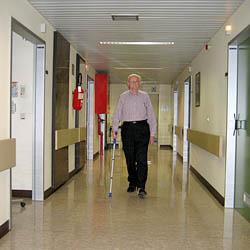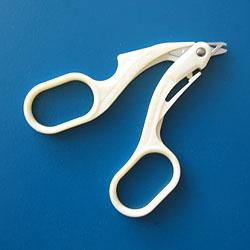Back home
Further exercises
Further exercises are useful and necessary to maintain the flexibility of the knee joint and to strengthen the thigh muscles. This is preferably done under the supervision of a physiotherapist of your choice. The prescription for the physiotherapist can be found at the bottom of the 'blue' information sheet: mobilization, dosed muscle exercises and further gait re-education. In this way you regain more independence from day to day, so that steps with one crutch and without crutch becomes possible.
Remember, however, that haste is completely wrong: the body will gradually adjust to your artificial knee.
The prescription for the physiotherapist is very important: no massage on the scar and no exercises that cause pain or overload. Therefore, urge your physiotherapist to strictly follow the prescription!
Blood-thinning syringes
A prescription for blood-thinning Clexane syringes is given with discharge. These can be administered by yourself or a home nurse can be called in. In total, these syringes are given for 14 days.
Dressing and brackets
If the wound remains dry, the dressing can safely remain closed for five days. If not, dressing changes should be done. If necessary, a home nurse can be called. The brackets may be removed by the general practitioner or nurse two weeks after the procedure. For this there is a special pliers that makes the removal of the brackets completely pain free.
Pain medication
At discharge from the hospital, the pain has largely disappeared. A painful rise can occur and can easily be treated with paracetamol using effervescent tablets or in pill form (max 4X 1g per day). Ice on the operated knee remainsvery efficiently against pain and swelling at home.
Complications that can occur at home
Further complications that can occur at home are just as rare as the complications in the hospital.
The formation of blood clots or phlebitis may occur at home and is avoided by daily blood-thinning Clexane injections.
Infection or infection can occur in a second time, so consult your doctor if you have a wound or if you have a fever.
A stiff feeling in the leg can occur temporarily. Excessive strength exercises are out of the question.
Re-learning the folds of the new knee joint is sometimes less smooth than expected. A "mobilization under anesthesia" can remedy this: the surgeon will fold the recalcitrant knee while the patient undergoes a very short anesthesia.


